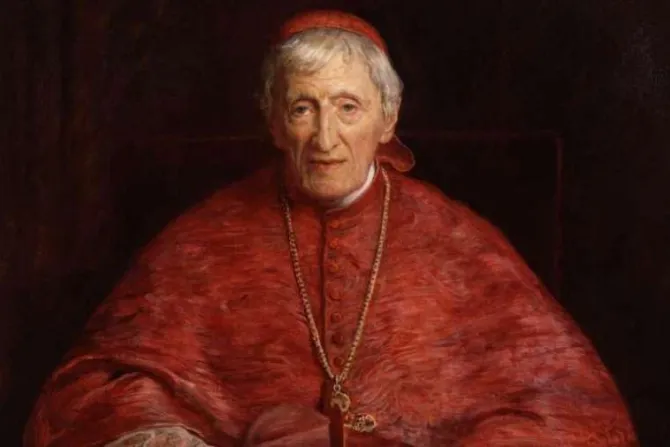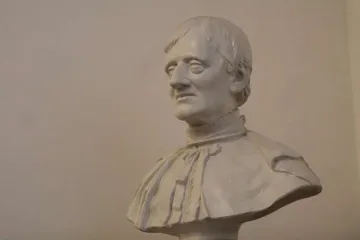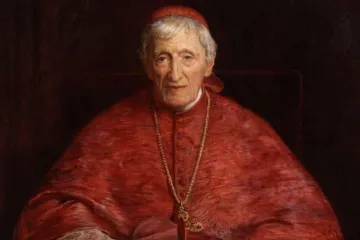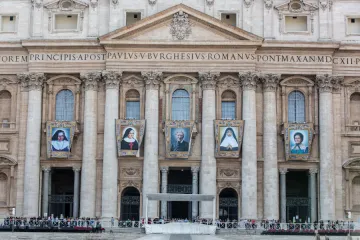Rome, Italy, Oct 11, 2019 / 12:12 pm
Cardinal John Henry Newman, who will be canonized Oct. 13, is more often associated with Birmingham than Rome, but his four visits to the Eternal City mark significant moments in the life of this soon-to-be saint.
An exhibit hosted by the Venerable English College and the British Embassy to the Holy See in Rome Oct. 10-14 demonstrates the significance of Newman's time in Rome, where he was ordained a Catholic priest, celebrated his first Mass, and discovered the Oratory of St. Philip Neri.
Newman's first time setting eyes on Rome was in 1833. An Anglican clergyman still years away from conversion, he wrote that he found the city to be "the most wonderful place in the world," and said even his "dear Oxford" is dust compared with Rome's "majesty and glory."
Newman also saw the Vatican Museums during the trip and was impressed by the beauty of Rome's churches, art, and sculpture.
But his anti-Catholic views also worked against his enjoyment of the Christian aspects of the city. He called Rome "cruel," because though he was awed by walking in the footsteps of the Apostles and saints martyred in Rome, he found the experience to be overshadowed by what were called Catholic "superstitions."
This visit, which lasted five weeks, also marked Newman's first time at a Mass. He attended a Mass said by Gregory XVI for the feast of the Annunciation at the Church of Santa Maria sopra Minerva.
It was during the Oxford professor's return journey from Italy to England that he composed the hymn "Lead Kindly Light."
His next visit to the Eternal City, and the longest, took place over a decade later, shortly after his conversion to Catholicism.
He came to Rome to prepare for the Catholic priesthood. Arriving Oct. 28, 1846, with his friend Ambrose St. John, they walked the next morning to St. Peter's Basilica to pray the Creed before the tomb of St. Peter. And when they arrived at the chapel of the relics, they found Bl. Pius IX celebrating Mass.
At that time, the college for students from mission countries preparing for priesthood was called the College of Propaganda Fide, located in a building near the Spanish Steps.
About studying at Propaganda Fide in Rome, Newman once wrote in his diary that he was "happy at Oriel, happier at Littlemore, as happy or happier still at Maryvale -- and happiest here."
During his 13 months in the city, Newman encountered the Congregation of the Oratory of St. Philip Neri, a fraternity of priests founded in Rome in 1575. He found the Oratory to be a beneficial way to live aspects of religious life in the context of the secular priesthood.
He asked permission to bring the Oratory to England, which was granted by the pope in February 1847.
Newman was ordained a Catholic priest May 30, 1847 at the Re Magi collegiate church inside the Propaganda Fide building. Newman celebrated his first Mass in another chapel of the building, at an altar above a shrine of martyr St. Hyacinth.
Later that year a novitiate was set up for his new English oratorians, and in December Newman returned to England, establishing the Oratory near Birmingham.
Newman's next appearance in Rome was for a less happy occasion. In 1856 he returned to the city to meet with the pope to resolve a dispute between the Birmingham Oratory and the newer London Oratory.
(Story continues below)
His fourth and final visit to the Eternal City was as a cardinal-elect. Newman had wanted to refuse the honor of being named cardinal, because he was worried he would have to leave the Birmingham Oratory to reside permanently in Rome. But Leo XIII made an exception for Newman, who was the first cardinal he created, bestowing upon him the red biretta May 13, 1879.
The exhibit at the Venerable English College brings together several artifacts connected to Newman and his Roman visits.
Among these are letters to Newman written by cardinals on behalf of the pope, first edition copies of his The Pope and the Revolution and his "Biglietto Speech," which he gave on the occasion of becoming a cardinal.
There is also an original letter from Newman to the then-prefect of Propaganda Fide in 1881, thanking him for sending a copy of an apostolic constitution by Leo XIII.
The temporary exhibit, which collects items from the College of Propaganda Fide, the International Centre of Newman Friends, the Anglican Centre, the Beda College, and the Venerable English College, also includes a large oil pastel portrait of the soon-to-be saint and a first class relic of his hair.






